Posted by Richard_Tomlinson on 08-16-2002 09:10 AM:
Another Kurdish Rug
Hi everyone
I have only (very) recently acquired this rug. It is
similar in design to the last rug Michael Wendorf has in the salon. Worn it is
but colours it has !!!


To me the border looks very
Caucasian. The field seems to be very Persianate. I was wondering how/where
this rug fits into a Kurdish tradition?
Thanks
Richard
Tomlinson
Posted by Michael Wendorf on 08-16-2002 11:55 PM:
where does it fit?
Hi Richard:
Thanks for the image and your thread. Very
interesting rug. This rug seems to be Kurdish and to come from northwestern
Iran. It is closely related to the last rug illustrated in the Salon, rug # 35.
I have heard this pattern with radiating leaves called Gol Hennai.
The
border does seem very Caucasian. I have heard this referred to as a zoomorphic
style border. But what is it really? It can also be interpreted as an
adaptation of a common warp substitution half arrow motif. The repetition of
this device using various colors can be interpreted as a means to unify two
distinct offset rows of half arrows. Marla Mallett has discussed this very
border in an article called Tracking the Archtype on her website. This article,
together with programs she has done at conferences, have been very illuminating
and worth following up on. In short, Marla has argued that motifs and patterns
evolve from the most restrictive to least restrictive technique. Warp
substitution is a restrictive technique common to bands, straps and jajims.
Knotted pile is not restrictive as a technique. Therefore, the argument is that
borders such as this flow from a flatweave tradition to knotted pile. This
relates to my argument that if we think about a Kurdish weaving tradition, the
tradition seems to have had its origins in relatively simple and restrictive
flatweave techniques. Since we know of Kurdish straps and jajims in warp
substitution, utilitarian weavings all, with this arrow and half arrow motif,
perhaps we need to reexamine the Caucasian nature of this border and question
again the role of Kurdish weavers.
As for the field, I think this is
generally interpreted as Persianate and by that one of a number of floral
patterns arising out of the influence of the Safavid dynasty. In Hali 70,
Alberto Levi published an article called Renewal and Innovation in which he
examined a number of rugs and carpets with Persianate designs. He argued that
Kurdish weavers appropriated Safavid designs in the 18th century and adapted
them into characteristically Kurdish carpets by use of scale and color. He
labelled these proto-kurdish. This label has stuck to some extent. I have
maintained that this mischaracterises any Kurdish weaving tradition that had a
long standing by the period in question. Nonetheless, there is no doubt that
Kurdish weavers wove rugs in the avshan, harshand and herati patterns and did
them in their own way, ways that I believe continue to reflect a tradition of
long standing and that has its origins in flatweaves. In Hali 70, he depicts a
few rugs with radiating leaves. The antecedents for this group of rugs, woven
in more than one village or area it seems, may be Safavid Dynasty patterns. But
this is far from clear.
Consider the possible relationship with the
following southeast Anatolian carpet of the 16-17th century in the Vakliflar
Museum
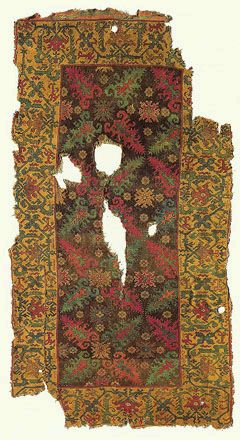
The rug has what would be a typical Kurdish structure and
came from Ulu Mosque, Divrigi (Sivas). See Carpets/Teppiche of Vakliflar p.
298, plate 61.
Perhaps this pattern has a tradition that predates the
Safavid dynasty. We can probably find fairly close antecedents in tiles and
textiles of the Mamluk era.
Something to think about. Thanks for the
post.
Michael
Posted by Guido Imbimbo on 08-17-2002 06:56
AM:
"Palmette", "Radiating leaves" and Mina-khani designs in Kurdish
carpets
Dear All,
First of all, I would like to thank Michael Wendorf for
the very interesting Salon and everybody for the following useful
discussion.
The two beautiful rugs presented separately by Richard
Tomlinson and Bob Kent give me the opportunity to offer some thoughts about the
Persianate/Kurdish motifs that are in the design of these and other carpets.
Let's start with the motif in the field of the carpet of Bob Kent, that
Michael Wendorf attributes to "Sauj Bulaq", the town called today Mahabad. I am
not sure how to call this motif. Allow me, for simplicity to refer to it as a
variant of "palmette" motif.
Figure 1 compares different
representations of this "palmette" motif in the field of some Kurdish (?) rugs.
In these carpet the the rendition off the "palmette" design is in a lattice
design.
Figure 1:
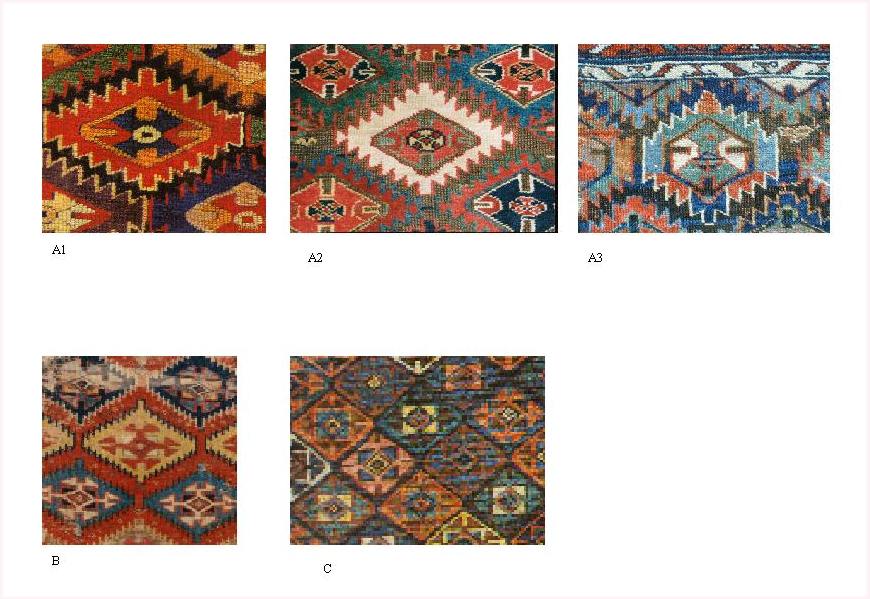
Picture A1 represents the Burns rugs published
in Hali 62; picture A2 comes from another unpublished rug and A3 is the Bob
Kent rug. The motif in picture B (unpublished carpet) is a variant of the
Burns's "palmette" where the design in the center of the "palmette" has been,
in some way, elongated. Finally, Picture C (p. 85 Alte Teppiche, Basel 1980)
shows the same elongated motif of picture B, but in this case the outlines of
the lattice are straight.
I have the images of several carpets with a
field similar to that in Picture B (6 including the above and one bag and Salon
Rug #24) and Picture C (4 including the above). One the example of Picture B
(lot 190, RB May 1995) does have three identical borders, a feature that has
been discussed by Michael in reference to the Bob's rug.
The rendition
of the Burns' "palmette" given in Picture A seems less common at least with
reference to overall lattice design. I knew only the above examples before the
Bob's rug surfaced on Turkotek. There are other examples of Kurdish rugs where
the motif A is present, though only a single non-lattice motif (Eagleton Pl. 8
and lot 69 SL, Apr. 2000).
Another well-known Kurdish motif may be
related to the "palmette" in Figure 1. I am referring to the so-called "stepped
diamond lattice" that has the most known rendition in the Dodds's carpet
illustrated in Plate 111 in ORAC book. In the Doods carpet the "stepped
diamonds" may recall, in a much larger scale, the "palmettes" in Figure 1 with
a different internal design in the diamond device. There are at least 6 other
examples similar to the Dodd's rug, including the beautiful piece from the
Wendorf's collection.
Where does the design depict in Pictures A, B and
C comes from?
In presenting the Burns's rug, the Hali's reviewer (I
believe James Opie) commented "the individual motifs 'saw-edged' outlines, are
related to those found on some early Anatolian village weavings, which may be
of Kurdish origin. A further consideration is the possible relationship of
these motifs to the Yomut kepse gul". This seems a very plausible connection. I
would like to offer a different one.
The 'saw-edged' outlines that are
present in carpets A and B are usually perceived as a container of the internal
design such to create a sort of device that we call "palmette", "diamond" or
"stepped diamond". I am suggesting instead that these "saw-edged outlines" are
the geometrical rendition of typical "leaves" that we find in many
Kurdish/Northwest Persian carpets.
Figure 2 shows for example a Kurdish
bag (lot 118 RB Nov 1992) where the typical "radiating leaves" are represented
in a very geometric form. According with my perception, the space that is
delimited by the leaves can be seen as the "palmette" of Figure 1.
There are a good number (at least 20) of Kurdish/Northwest Persian
carpets with "radiating leaves". The leaves are represented both in the
"geometrical" form of Figure 2 and in the more "naturalistic" version of the
Salon rug # 35 and the Richard Tomlinson's carpet.
Figure 2:
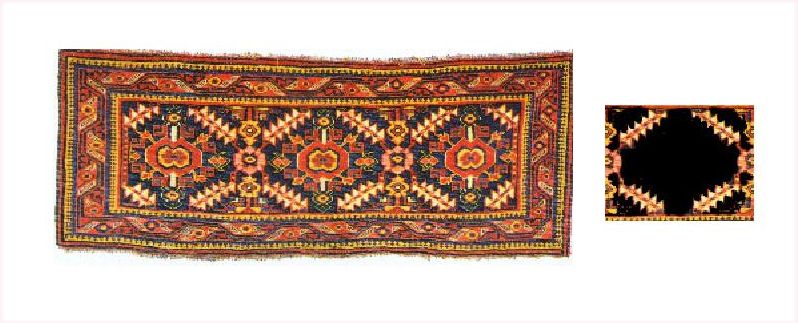
Probably one of the oldest carpet with "radiating leaves"
is shown in Figure 3 (lot 27 Phillips, June 1992 reviewed in Hali 64, p. 167,
dated late 18th century). Close to the Phillips rug, I included the picture of
an old rug (unpublished) with Mina Khani design. The relation between the two
old pieces seems obvious to me.
Figure 3:
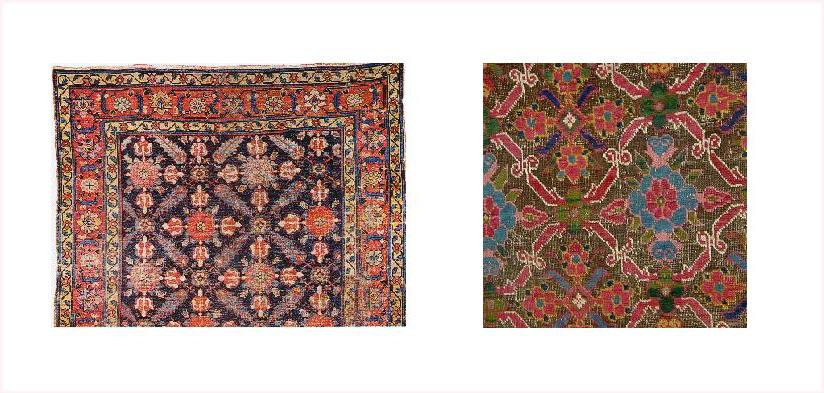
Best
Regards
Guido Imbimbo
Posted by Michael Wendorf on
08-17-2002 10:17 PM:
saw edge or serrated medallion?
Hi Guido:
Good to hear from you.
Your theory that these
saw edges are geometrical drawing of leaves is an interesting one. Perhaps one
needs to see or think of the leaves and the palmettes or medallion as being, in
effect, on different levels or planes to see what you are arguing. The use of
multiplanes of design is very Islamic. But compare the long rug in the Salon
with the orange lattice and shrubs, to me it is not leaves but just a stepped
polygon created by the lattice work in which various shrubs are placed. This,
to me, represents not leaves but just a geometric form from a flatweave
tradition adapted to knotted pile with floral forms woven in - shrubs.
Wendel Swan made a different, but related argument, about the leaf and
calyx border at the Philadelphia ICOC- that it is geometric. But, I believe, he
would not accept it as floral. You are saying the drawing of what we see as a
ground color is geometric, but still leaves.
I am not sure about this
theory, it seems to be contrary to the idea of such devices as what you are
calling palmettes, or that we could in some examples call medallions, come out
of a flatweave tradition. And it ignores the large number of carpets that were
woven where the saw edged medallions are just scattered on a field with no
lattice of any kind.
No doubt, though, that leaves in the basic format
of rug #35 and Richard's rug are known from several areas. Among these is a
group we have not yet discussed and that is the group of large woroshop pieces
usually with a yellow ground that were probably made somewhere in western
Azerbaijan, perhaps in or near the Herez district. One of the great examples
was in Asiatische Teppich und Textilkunst Band 4 published by the Hermanns. He
attributes his piece, plate 64, to Sauj Bulaq - but I doubt it. Other examples
in Hali 31, p. 89; Grote-Hasenbalg, bd. III, plate 64. These pieces are closest
in drawing to figure 3, the Philips rug.
Hope to hear more from you in
this discussion,
Regards, Michael
Posted by Guido Imbimbo on
08-18-2002 04:34 AM:
"Palmette", "Radiating leaves" and Mina-khani designs in Kurdish
carpets
Dear Michael,
Thank you for your post.
I understand your
hesitation to accept my view that Kurdish rugs like the Burns one with a
repetitive "motifs with 'saw-edged' outlines" in a lattice organization may
derive from a floral/garden compartmental Persianate tradition. Your hesitation
grows when I connected to this floral tradition also to Kurdish rug like the
"stepped diamond lattice" Dodds's ORAC piece. You see those devices more as
simple "medallions".
I find instead more difficult to understand your
reading/interpretation of the beautiful shrubs long rug (Salon Rug #25),
particularly in relation with my leaves/floral argument. You wrote:
"But
compare the long rug in the Salon with the orange lattice and shrubs, to me it
is not leaves but just a stepped polygon created by the lattice work in which
various shrubs are placed. This, to me, represents not leaves but just a
geometric form from a flatweave tradition adapted to knotted pile with floral
forms woven in - shrubs".
Figure 1 shows a detail of your Salon shrubs
rug compared with a detail of an early Kurdish rug analyzed by Alberto Levi in
his article in Hali 70 (Plate 3, page 86). In the latter carpet the lattice
device that contains the individual shrubs is designed using naturalistic
leaves. I leave to you the conclusion if in your shrubs rug the
lattice/compartment organization derives more from a floral tradition (leaves,
tendrils, etc.) or rather " just a geometric form from a flatweave
tradition".
Figure 1
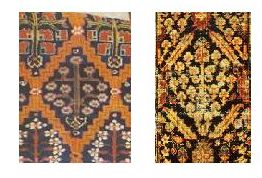
In the article Levi's comment of
the carpet is: "The vertical shape of the compartments recalls in some respect
the graphic layout of garden carpets…. The third compartment is
characterised by a dark ground colour on which we see a variant of the
mina-khani pattern. All of these characteristics derive from that great
ensemble of early Safavid designs that are grouped under the heading of carpets
woven in the vase technique" (p. 92-93).
I find very useful your recall
of the flat-weave tradition in understand the design of Kurdish rugs. I
don’t understand, though, why my argument (a relation of the motifs that
we find in late Kurdish rugs with the floral/compartment Persianate tradition)
is contrary to the flat-weave tradition. Your statement implies that there is
no connection whatsoever between the design repertoire of the flat-weave
production and the "floral" design carpet tradition. But it is not my intention
here to open the Pandora vase of the flat-weave design
interpretation.
Thank you
Guido
Posted by Bob Kent on
08-18-2002 08:25 AM:
A2 rug, leafy lines
Great discussion, thanks. Guido, can you post a full image of the A2
rug?
For what it's worth, the serrated outer edges in my rug are
completed differently in the half-medallions/palmettes/whatever at the ends of
alternating rows (see later photos in the "Sauj Bulagh" thread). Here the
sawtooth lines are given serrated inner boundaries, different color segmenting,
and sometimes even central veins to make leaves. These explicit leaves are
often similar in shape to the negative spaces between the sawtooth medallions,
but the higher pile of the design versus the corroded field tends to keep them
in different planes.
Posted by Bob Kent on 08-18-2002 08:57 AM:
better images...
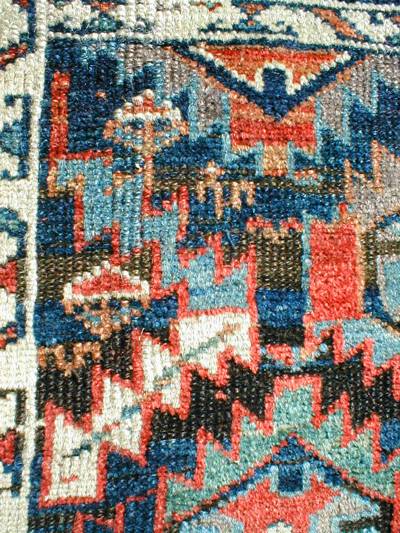
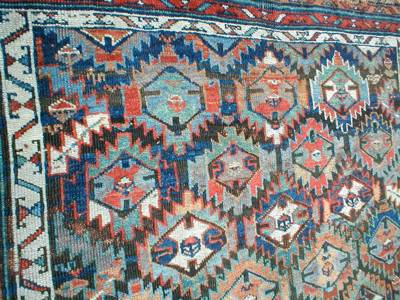
Posted by Michael Wendorf on 08-18-2002
12:05 PM:
flatweave and floral traditions
Hi Guido and fellow readers:
Well, I hope that I am not implying
there is no connection whatsoever between the design repertoire of the
flatweave tradition/production and the "floral" design carpet tradition. I
think there may be and probably is, but it is very difficult to understand or
put in perspective. Perhaps we are stumbling over a kind of chicken and egg
dilemna, which came first?
With regard to the long rug # 25 - to
understand what I am describing one needs to consider and look at it compared
to the common stepped polygons rugs that we all know. For example, the rugs
numbered 18 and 26 in the Salon following rug # 25. In each case we see a rug
consisting of an all-over pattern in which the pattern consists entirely of
stepped polygons. Interlocking these polygons in a ground that could also be
interpreted as a lattice. In one rug, it is even orange. In my mind these are
simple knotted pile rugs arising directly out of a flatweave tradition. Color
and color juxtaposition distinguishes one from another.
If we now keep
the ground or lattice but remove the rest of the "polygon" and replace it with
a shrub we have a rug that is very similar to rug # 25. It seems to me that the
stepped polygon rugs come from a flatweave tradition and are completely
geometric first. If you are correct that this lattice is a geometric rendition
of leaves, it seems to me that the appearance of these leave or floral looking
lattices could well be a later innovation resulting from floral influences as
well as the adaptablity of the less restrictive technique - knotted pile.
I do not find the rug Levi illustrates on page 86 of Hali 70 (plate 3)
particularly persuasive of a floral/leave influence resulting in rugs like my #
25. This rug is a so-called caned type and the vertical compartments contain
numerous different floral designs - even arabesques. It is almost as if this
rug is meant to showcase all the different floral forms this workshop have in
its repertoire. Perhaps it is a response to the same forces that were at work
on the flatweave tradition and the rise in prominenece of knotted
pile.
Very interesting and creative idea you propose, I would like to
read more about your thoughts on this.
Thanks, michael
Posted by Steve Price on 08-20-2002 12:20 PM:
Hi People,
Guido Imbimbo sent me this image. It's the full image
of Slide A2 that Bob Kent asked to see:

Thanks, Guido,
Steve Price
Posted by Richard
Tomlinson on 08-21-2002 08:53 AM:
Hello all
Thanks to everybody for your illuminating comments. I
have learnt a lot from this thread, and there is scope for me to learn a lot
lot more.
As this discussion appears almost at an end, I would like to
pose one more question.
I was sitting looking at this rug last evening,
admiring the the wonderful colours when I suddenly realised that I had NEVER
seen another Kurdish RUG with the aubergine/eggplant colour that this rug has.
I have not been collecting for long but from memory I can only recall seeing
this colour in a few Jaff bagfaces.
I have seen many Caucasian,
Anatolian, and Beluch pieces with aubergine but not Kurd.I was wondering how
common a thing it was for Kurdish weavers to use this particular colour in
rugs.
Thanks
Richard Tomlinson
Posted by Michael
Wendorf on 08-21-2002 03:38 PM:
eggplant, purple, violet and aubergine
Hi Richard:
Purple is generally a good marker for older rugs, not
just Kurdish rugs. However, it can be tricky. As you have observed, purple
appears in Jaf bags well into the 1920s. Makes one wonder a bit about the
circumstances in which some of these Jaf pile bags were woven. In my
experience, purple is found quite frequently in older Sauj Bulaq area rugs and
other Kurdish rugs we might refer to as village rugs. Rug 20, the Kagizman rug
discussed in that thread has a lot of purple or violet in it. But we also find
a violet brown color in the wefts of some Kurdish rugs from
Anatolia.
The reason I think purple tends to be a good marker for older
rugs is that is tends to be lost as we move closer to the 20th century. The
reasons are several. Fuscine replaced it around 1870, rugs tended to become
more monochromatic as we moved forward and some of the older dye formulas seem
to be lost or forgotten. Purple can be created in one of two ways. In Iran,
purple tends to be the result of indigo being overdyed with madder red or
cochineal. In eastern Anatolia, purple is often the mix of two madder dyes,
alizarin and pseudo-purpurin, with iron as a mordant. According to Rugs of
Anatolia, either the purple was extracted from the madder root or there are
madder root varieties with only small amounts of purpurin. See page 108. The
knowledge of this process was apparently lost in the late 19th century. On a
related subject to this, I think it is also a good marker to look for multiple
shades or hues of the same basic color. For example, you see several reds in
your rug whether you count purple, as I would, or not. This, like purple, tends
to disappear in later rugs.
Thanks for participating in the Salon. It
will close on August 23 and final comments are welcome from
all.
Regards, Michael
Posted by Daniel_Deschuyteneer on
08-21-2002 05:50 PM:
Dear Richard,
Here are three close-up of a rug very similar to
yours. As you can see it contains also a lot of this extremely nice aubergine.
I can't post a full photo of it as it is in a dealer's friend hand but will
send you one privately aside the board.
Michael has slides of this rug
and know it very well.
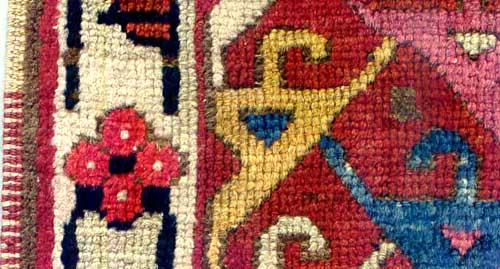
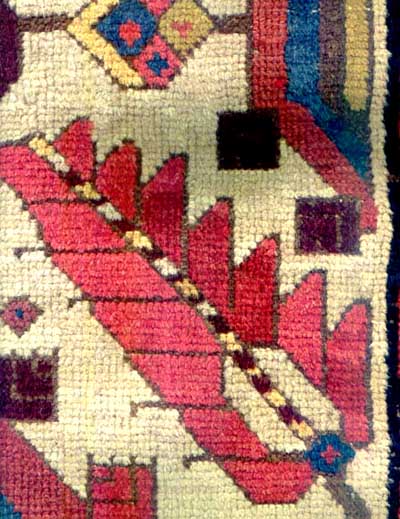
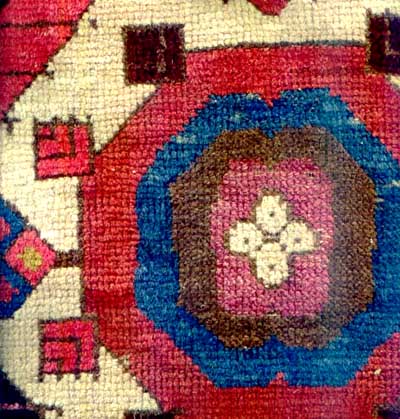
Best,
Deschuyteneer Daniel
daniel-d@skynet.be
Posted by
Michael Wendorf on 08-21-2002 06:12 PM:
purples
Greetings:
As we can see from the images Daniel has posted of his
rug and comparing them to Richard's rug, even within the same design family the
colors can be quite distinct. The purple in Richard's rug has to my eyes more
of an eggplant tone to it while on my monitor it appears that Daniel's rug has
two purples - a deep brownish purple and another lighter reddish purple (seen
in the first and third photos) with what looks like a hint of cochineal to it
(suggesting an indigo blue overdyed with cochineal?) - almost a lilac. Notice
the other red colors as well.
Thanks for the images, michael
Posted by Daniel_Deschuyteneer on 08-22-2002 10:00 AM:
Hi Michael,
I am coming back to the saw edges motif presented by
Guido in his first posting.
You tell us that this motif has been
transferred from the flatweave tradition. I am imagining you are referring to
flatweaves woven with restrictive technique (slit tapestry…). If it is, I
am not sharing your thoughts. These saw edges medallions/palmette don’t
show any technique-generated detail. The serrated saw edges are too linear,
drawn with vertical and diagonal serrations, and according to Marla Mallett 's
article “Tracking the archetype” available on her website, are
standard knotted-pile carpet devices. Read back her lecture , and you will
agree with me.
PS: it would have been possible to draw such medallions
using weft substitution weave but it is not very restrictive and this technique
wasn’t used by the Kurds of the heartland or by their
neighbours.
Hi Guido,
Each time such serrated medallions are
arranged together in a kind of grid, KIND OF geometric leaves will appear
between them, in the negative spaces. This is, to create a new word, what I
would call “design/lay-out generated” pseudo-geometric leaves as seen
in B.

Let us coming back to the original and naturalistic
rendering of these leaves as seen in your figure 2 and 3. Each time we see
“four leaves radiating from one central floral palmette”.

It’s also what we see in the figure 1 of your second
posting comparing the Salon shrubs rug and the Levi’s rug.

Here I
share your thoughts. Yes, the similarities are obvious. This design has not
been transferred from flatweaves. The floral palmette and the radiating leaves
are well seen in the Levi’s rug close up, and REMNANTS of these floral
palmette ARE STILL VISIBLE IN Michael’s rug, where the lattice is
therefore certainly a geometric rendition of the more naturalistic Levi’s
design.
Thanks,
Daniel
Posted by Michael Wendorf on
08-22-2002 10:44 AM:
vertical serrations
Hi Daniel, Guido, Bob and all:
I think you observe and point out
an important fact, that is the vertical/linear nature of the saw
edges/serrations on some of these medallions. I have struggled with this for
some time. You may recall another rug that is related in this way:
www.turkotek.com/salon_00087/Jerry11.jpg
These
pieces have always seemed to me to be powerful and timeless in design. But I
agree with you that, weft substitution aside, the drawing is not necessarily
copied directly from a restrictive technique. If it were, we would expect to
see a more diagonal orientation, stabilizing elements etc. My thinking, perhaps
weavers reinterpreted/adapted a slit tapestry design in a less restrictive
technique, knotted pile, rather than copied it directly - an innovation if you
will - because in many ways these rugs feel more basic and less floral to me
subjectively. Could be my mistake or bias.
The grid is an interesting
explanation for what Guido has observed and written about in the ground or
negative space of these rugs. Ultimately, i still think we have a chicken and
egg issue concerning the floral nature of this. On my rug, it is true that a
little rosette is drawn on the lattice at intersecting points. But if you take
out the shrub and look only at the lattice, it is a stepped polygon. It could
be that the floral effect of the other pieces is an innovation by weavers who
obseved this grid and were influenced by floral designs flowing from the
Safavid Dynasty and forward, the Persianate designs. Keep in mind that there
are numerous rugs with either randomly placed or a few exploded in scale saw
edged medallions in which neither a grid nor anything floral, rosette or
palmette, can be seen.
Interesting questions both of these,
thanks.
Regards, Michael
Posted by Guido Imbimbo on
08-23-2002 10:05 AM:
Final Thoughts
Dear Michael and all participants,
I would like to accept the
invitation of Michael and offer to you my last thought on the interesting topic
of design origination in tribal Kurdish rugs.
The floral lattice/grid is
a device that has been often used several in Persian Safavid carpets ("gardens"
and "vase" carpets) and in classical Mughol carpets. It can be find even in
early Caucasian carpets, namely the so-called "Dragon carpets" (see for example
pl. 103 at p. 243 in Spuhler book).
It also well known that the floral
grid structure has been adopted in later carpets, particularly in the late 19th
century rugs production of Caucasian workshops. There are dozen o pages of
examples in the Bennett book (for example plates from 420 to 432 in the
"Daghestan" section). The design of these rugs is clearly inspired by the
floral/garden Persian tradition. Both the flower/shrubs element in the grid and
the lattice itself acquire in this production an increasingly rigid and
geometrical rendition.
We have also noticed that a distinctive group of
carpets with "radial leaves" composition probably produced in the Northwest
Persia region follow a similar path. In some pieces like the bag in Fig. 2 of
my original post the leaves design become almost completely geometric (see for
example also lot 68 SNY Sep 1993 and lot 21 Lefevre July 1980). All these
carpets maintain a repetitive grid/lattice design.
On the basis of this
evidence I believe that is now quite reasonable to consider carpets like the
long rug #24 in the Salon with lattice and shrubs as a late adaptation of a
floral/garden carpet tradition also in the lattice execution. This is confirmed
also by the observation that well-drawn flowers represent the knots in the grid
of the lattice. This is an important detail that has been already mention by
Michael.
With this background, it is possible to examine the idea that
also other Kurdish rugs that present a more geometrical device organized in a
typical repetitive structure (Fig. A1, A2, A3, B, C, Salon rugs #28, #29 and
Jerry rug) may have a "floral connection". In this group of rugs may fall also
other production, like the Dodds' piece.
Mine therefore is just a
tentative to answer to the question about the nature of the stepped
diamond/saw-hedged device and the (apparent) grid that contains such
elements.
At this point I want also avoid a possible misunderstanding.
My idea that does imply (and I do not believe) that the groups of carpets
described above are simply the result of a historical degeneration of
floral/garden tradition in carpets design. For me it is more safe to say that
there are elements that are common a both traditions.
The use of
geometric elements and pattern is a very central feature of classical Islamic
architecture and decoration. Often the application of geometric elements was
based on precise mathematical principles that allowed decorating vast surface
and extremely complex configuration (see George Mitchell book on Islamic
Architecture p. 168-9).
Figure 1 shows details of the Great Mosque at
Damgham, Iran and the tomb of Akbar at Sikandra, India. Some of us may recall
in these architectural details, the stepped-diamond elements of the Michael's
rugs. At the same time, Islamic geometrical decoration used also the "circle"
and "star" elements combining them with floral patterns like rosettes and
trellis in a bewildering variety of effects.
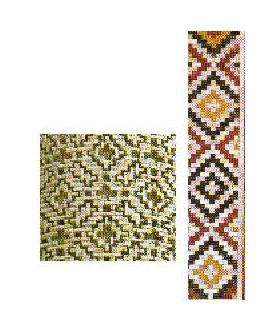
Thank
you
Guido













